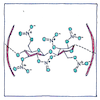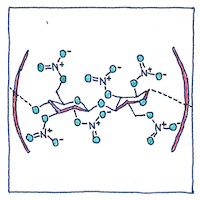Christian Friedrich Schönbein,
Rudolf Christian Böttger,
F. J. Otto
chemistry

|
Guncotton
In the 1830s three French chemists discovered that nitric acid combined with wood fibers or paper produced highly unstable combustible nitrocellulose. Henri Braconnot and Théophile-Jules Pelouze, teacher of Ascanio Sobrero and Alfred Nobel, called their nitrocellulose xyloïdine. Jean-Baptiste Dumas called his nitramidine. In 1846, three chemists independently discovered a way to produce a practical and stable form of nitrocellulose, later called guncotton. Christian F. Schönbein discovered it by accident and collaborated with Rudolf Christian Böttger, who had already discovered it but F. J. Otto had also discovered it and was the first to publish. To make guncotton, dip cotton in a strong solution of 30% nitric and 70% sulphuric acids. Drain the acid, replace with water, boil and wash repeatedly, then dry.
Practical uses
A blasting explosive, an explosive for naval mines and torpedos, smokeless gunpowders for firearms and artillery including Paul Vieille’s Poudre B, an ingredient in cordite and Alfred Nobel’s Ballistite, a solid rocket fuel, and the explosive in Jules Verne’s columbiad to blast three men to the moon.
Oxymorons
“Guncotton” sounds soft but don’t stuff it in your pillow. It’s not a safe explosive. If it would kill only bad people and win only just wars, it would be awfully good.



Schönbein called it “schiesswolle,” which could also be translated “shooting wool.” Guncotton’s applications for munitions were immediately obvious. It detonates with six times the force of gunpowder and produces less heat and less smoke.
See also in The book of science:
Readings in wikipedia: